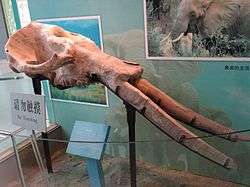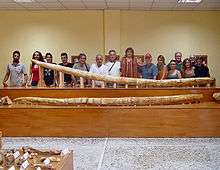Zygolophodon
| Zygolophodon Temporal range: 17–0.781 Ma | |
|---|---|
 | |
| Skull | |
| Scientific classification | |
| Kingdom: | Animalia |
| Phylum: | Chordata |
| Class: | Mammalia |
| Order: | Proboscidea |
| Family: | †Mammutidae |
| Genus: | †Zygolophodon Vacek 1877 |
| Species | |
| |
 | |
| The inferred range of Zygolophodon | |
| Synonyms | |
| |
Zygolophodon is an extinct genus of African, Asian, North American and European mammutid that lived from the Miocene to the Middle Pleistocene.[1][2] It may have evolved from Tetralophodon. While collecting fossils in the Clarno Formation of Oregon during 1941, noted paleobotanists Alonzo W. Hancock and Chester A. Arnold recovered the most complete Zygolophodon skull known at the time.
It was one of the largest terrestrial mammals of all time. With a shoulder height of about 3.9–4.1 metres (12.8–13.5 ft) and a weight of about 14–16 tonnes (15–18 short tons), it approached the size of Paraceratherium, and was heavier than several sauropod dinosaurs.[3]

Zygolophodon tapiroides tusks excavated in Greece
Zygolophodon skull
References
- ↑ Freeman, Leslie G. (1978-01-01). Views of the Past: Essays in Old World Prehistory and Paleanthropology. Walter de Gruyter. ISBN 9783110800074.
- ↑ Youping, Yuzhu, Hongxiang, Suyin, Zhang, Long, Ji, Ding (November 1999) [March 1989]. "The Cenozoic Deposits of the Yunnnan Region (Institute of Vertebrate Paleontology, Paleoanthropology Academia Sinica)" (PDF). Professional Papers on Stratigraphy and Paleontology, No. 7 Geological Publishing House, Peking, China, pp. 1-21.
- ↑ Larramendi, A. (2016). "Shoulder height, body mass and shape of proboscideans" (PDF). Acta Palaeontologica Polonica. 61. doi:10.4202/app.00136.2014.
This article is issued from Wikipedia - version of the 11/25/2016. The text is available under the Creative Commons Attribution/Share Alike but additional terms may apply for the media files.